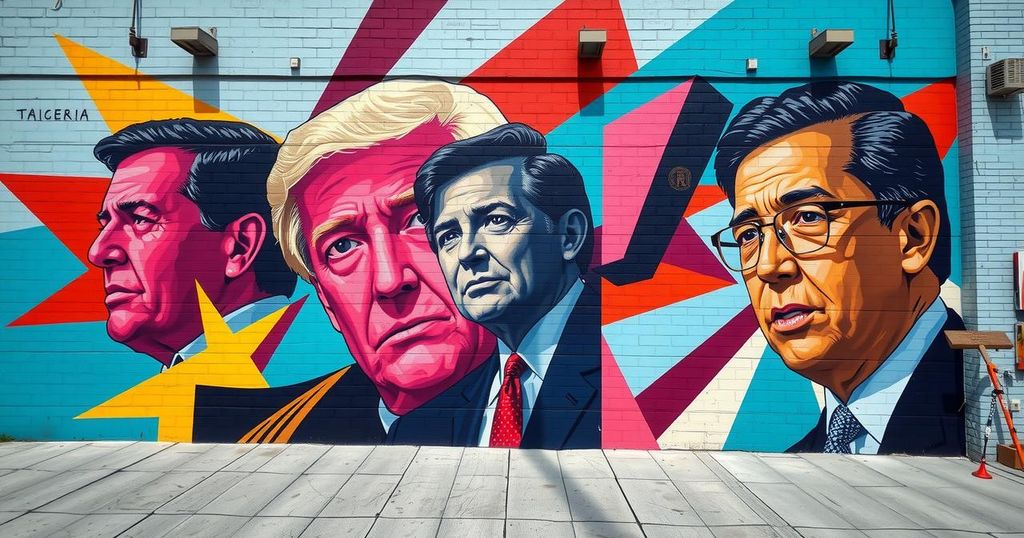Trump’s 13 Biggest Lies in His First Month Back in Office
In just a month back in the White House, President Donald Trump has once again stirred the pot, displaying a dizzying ability to weave his own version of reality. A closer examination reveals that since his inauguration on January 20, he has amassed a list of what have been dubbed his 13 biggest lies. From wild fabrications regarding condom funding for Gaza to outlandish claims about the youth vote, Trump’s statements have often blurred the line between reality and fiction. Brimming with a variety of misleading declarations, his first month has been nothing short of chaotic for observers of his political journey.
A whirlwind of distortions in Washington
In just his first month back in the Oval Office, President Donald Trump has been making headlines—not only for his rapid policy shifts but also for a torrent of misleading statements. It’s astonishing to see how quickly he has returned to form, spinning fabrications in his speeches and social media posts with a dexterity that seems almost rehearsed. Reports suggest he has managed to cover an array of topics, using exaggeration and outright lies in a way that leaves many questioning the truth behind his claims. Let’s delve into some of the most egregious inaccuracies that have marked this controversial return to political life.
The curious case of inflatable dollar figures
One of Trump’s most eyebrow-raising claims involved an alleged $50 million funding plan for condoms aimed at Gaza, a statement that Press Secretary Karoline Leavitt brought to light during a briefing. Immediately, the lack of supporting evidence raised eyebrows, yet Trump persisted with the increase, going from $50 million to a staggering $100 million destined for Hamas. This isn’t an isolated incident; it’s a pattern often referred to as “Trumpflation,” where his tall tales just keep inflating until they are almost unrecognizable from their original form. For a president, it’s an alarming tactic.
Blame game: Ukraine and the war narrative
In another astonishing twist, Trump claimed during a recent interaction that Ukraine was to blame for the war it is currently embroiled in—conveniently sidestepping the fact that Russia invaded Ukraine first. His remarks echoed that of Kremlin propaganda, suggesting that Ukraine could have averted everything had they simply made a deal. This is a troubling shift from the facts and seems more like a political strategy than a reflection of reality. It raises questions about how misinformation spreads and influences perceptions.
Misunderstanding birthright citizenship
Continuing on the misinformation train, Trump brought up the issue of birthright citizenship, asserting that the United States was unique in offering this right. The math simply doesn’t add up as countless nations, including Canada and Mexico, also extend this welcome to newborns on their soil. This apparent lack of fact-checking before stating such opinions comes off as reckless, suggesting either disinterest or a conscious effort to mislead. It’s a dangerous narrative when citizenship, a fundamental aspect of human rights, is trivialised.
Revising the narrative of January 6
Trump’s characterization of January 6—casting the rioters as victims of government oppression—stretched credulity. His assertion that individuals who assaulted law enforcement were actually assaulted has been debunked thoroughly. The reality is stark and undeniable, backed by a multitude of videos and testimonies. With over 140 officers reporting assaults during that fateful day, Trump’s distortion of events is not merely erroneous—it borders on reckless disregard for a tragic incident that resulted in several deaths and injuries.
Water policy and wildfires: A confusing tale
And let’s not forget about Trump’s take on infrastructure issues, specifically water policy in California. Amid the devastating wildfires, Trump made a bizarre connection between the fires and a fish protection policy. Experts were quick to disabuse him of this fantastical linkage, yet he carried on by announcing the release of billions of gallons of water from the Central Valley with no clear purpose, misleading people into believing that this water was Gushing into Los Angeles while, in fact, it was heading nowhere near the city.
An endless cycle of election lies
The insistence on repeating the claim that the 2020 election was ‘rigged’ continues to be a hallmark of Trump’s narrative—defying the very essence of democratic principles. During a series of events on his supposed inauguration day in 2025, he once again fell back on this line, showing either a profound denial of the truth or a strategic ploy to rally his base. It’s a point many have moved beyond, yet he clings to it vehemently, showcasing a refusal to accept the democratic outcome of the election.
Transgender athletes: A precarious narrative
Trump has also revived his claims about transgender athletes in a rather bizarre twist involving Olympic champions. He has been known to spin tales about their supposed transitions, fundamentally misrepresenting their identities and achievements. Not only are these fabrications damaging, but they also mislead the public about important discussions around gender and sports—misleading information that has repercussions especially when the Olympic Committee has consistently corrected these stories.
Fiction and fact: Trump’s Canadian narratives
All this serves as a reminder of the fictional landscape Trump often creates around Canada, highlighting how his statements don’t reflect the reality of American-Canadian relations. The idea that Canadians welcomed the notion of becoming the 51st state is laughable—quite the opposite sentiment actually exists. Distortions surrounding financial transactions and business regulations have also made headlines. His claims need backing with facts when they touch international borders and national identities.
Diversity initiatives: A scapegoat?
After the tragic collision of a military helicopter and a civilian aircraft earlier this year, Trump descended again into mischaracterization by attributing blame to FAA diversity initiatives without providing solid evidence. This initiative—a continuation of a policy introduced in his own administration—was retrofitted into his narrative. This sort of spinning shows a lack of accountability and a penchant for deflecting criticism by crafting tall stories instead of presenting facts.
The truth behind tariff costs
As evidenced by his presidency thus far, Trump’s economic policies have often simplified complex issues into misleading soundbites. When discussing tariffs, he’s frequently suggested that they are costing foreign countries. In reality, studies indicate that American importers are the ones footing the bill. It remains vital that the public understand where the financial burdens truly lie, especially in the wake of policy changes intended to assuage fears of economic loss.
The autism-vaccine controversy revisited
Lastly, Trump has recently flirted with the debunked association between vaccines and autism, leading to inflated statistics about autism’s incidence among children. His overstated claims reverberate through social media, impacting perceptions around public health. Experts highlight that the increase in autism spectrum diagnoses over the years is likely due to better screening and awareness rather than any nefarious side effects from vaccinations.
Fabricated narratives about China and Panama
What’s most bewildering is his outlandish assertion regarding China managing the Panama Canal, spinning tales that emerge directly from his speeches and would have the public believe inaccuracies about foreign governance. Panama continues to operate the canal, and Trump’s references to the site have threatened to obscure the real issues at hand—a lack of genuine discourse about real power dynamics.
Inflated claims about the youth vote
Finally, Trump appears unwilling to shy away from overstating his accomplishments, claiming he won the youth vote ‘by 36 points’ during the 2024 election against Kamala Harris. Exit polls, however, tell a different story that suggests he lost this crucial demographic. Continually mixing truth with fiction, Trump’s narrative construction requires scrutiny; it risks normalising deception in democratic discourse.
What patterns can we observe in Trump’s statements?
Trump’s statements have often been filled with exaggerations and outright lies, which raises significant concerns about honesty in politics.
Has Trump made any controversial statements regarding public health?
Experts in both fields have frequently pointed out that childhood vaccines do not cause autism. This claim remains part of a broader public health discussion.
How does Trump’s lying affect his political support?
The patterns suggest that misinformation has become a tool for political strategy, possibly as a way to rally support while diverting attention from pressing issues.
Why is it important to fact-check political statements?
Scholars and researchers have noted that maintaining an accurate narrative is vital for public trust, especially in democratic contexts where misinformation thrives.
Are Trump’s claims on any topic verifiably false?
Ultimately, yes. Each of these claims has been refuted by various reputable sources, and continuing to spread such narratives poses a threat to informed public discourse.




